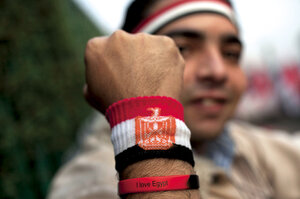New pride in Egypt's national colors
The Egyptian flag can be seen painted on billboards, featured in advertisements and worn as head scarves in sweeping statements of national pride.

A wristband made with the colors of the Egyptian flag.
Bernat Armangue/AP
Cairo
• A local, slice-of-life story from a Monitor correspondent.
Flag-waving was once a phenomenon only seen on the streets of Egypt before and after soccer games. And it has never been a normal sight to find Egypt’s flag hung in windows. But the country’s 18-day revolution succeeded in reviving the significance of the Egyptian flag as a symbol of national pride.
Egyptians now rally around their flag, which has come to represent the outburst of nationalistic fervor released by last year’s revolution.
“Five or six years ago, our national flag meant nothing to us,” says Maha Hamdy, a creative director at an advertising agency. “But after the revolution, our perception of the flag reflects a strong sense of belonging.”
Egypt’s current flag – with its red, white, and black horizontal bands and the eagle of Saladin – was introduced by the Free Officers, who ascended to power in 1952. Yet unlike Libya’s insurgents, who hoisted the flag of the monarchy, most Egyptians have come to view their national flag as a symbol of their revolt.
In addition to its growing political significance, Egypt’s flag has become the latest fashion frenzy – as a headband, a head scarf, and even a niqab (face veil). Businesses are capitalizing on the phenomenon by displaying the flag on products and advertisements. The national colors appear on everything from rings and dresses to billboards.
Ms. Hamdy says more clients are using a patriotic tone in their ads since the revolution. “Using the flag in different forms has become equivalent to making a statement about one’s nationalistic sentiments,” she adds.

